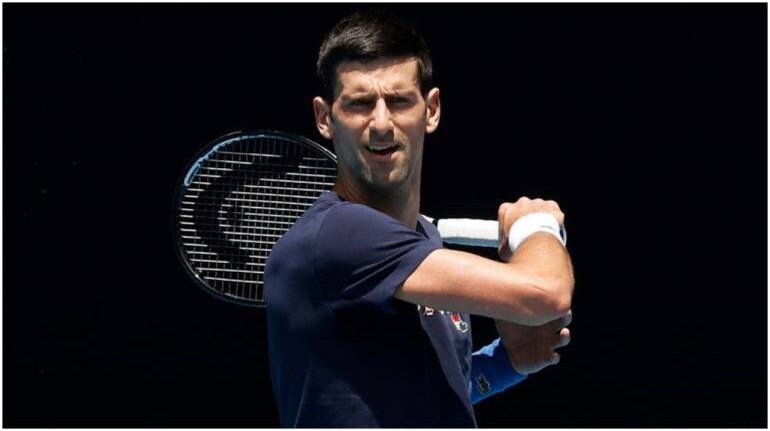



Roughly around this time last year, Novak Djokovic had the first three Grand Slams of the year in his pocket. He was then gunning for all four, to become the first man since Rod Laver in 1969 to win all in a single calendar year. He was primed to take his tally of singles majors to 21, past the other greats of his generation Roger Federer and Rafael Nadal, then tied at 20.
A year later, much has changed for him, but not in the way he would have desired. For one, he is still stuck on 20, while Nadal has raced ahead to 22 after winning the Australian and French Opens. Federer is pretty much out of contention—so the competition for the highest number is between these two.
Djokovic has played only two Grand Slams this year—one of which in Paris is over and another ongoing at Wimbledon. He cannot contest in the last one at the US Open in August—as of now—because the US government is not currently allowing unvaccinated players to participate. This reduces Djokovic’s imminent chances of catching up with the Spaniard and triangulates all the pressure to the course of this week.
Djokovic’s anti-vaccination status and stand not only got him thrown out of the Australian Open in the beginning of the year, but has also cut short his tryst with several records that he seemed to be cruising towards.
As a result, the year 2022 has netted him just one ATP title—in Rome on clay in May—of the six events he has played. He has consequently dropped down from his number one ranking, a position he held for a record 373 weeks, and currently finds himself at three.
Besides the ranking, the Melbourne-Australian Open experience cost him some popularity and support—both of which he generally finds himself short of, given the more charismatic Federer and Nadal in fray. Through all of this, the highs of 2021 have come undone with a crashing thud.
The Serbian will not be able to compete in some of the big ranking points tournaments going further this year because the American hardcourt season follows Wimbledon as a run up to the US Open starting 29 August. The National Bank Open in Montreal and Western & Southern Open in Cincinnati, the two ATP events with big ranking points before the US Open, are probably out of bounds for him, leaving the Hamburg European Open as the only hefty event immediately after Wimbledon for Djokovic.
Since he has been banned from entering Australia for three years after this year’s fiasco, his next Grand Slam after this week would possibly come only in May 2023 at Roland Garros—unless Australia reverses its decision. All of this means a further decline in ranking, lack of big match practice and ramifications on his mental strength to deal with the challenges.
“Having not played a Slam match since the (US) Open, I think it caught up with him there (at Roland Garros). Now he’s got that even more ramped up pressure that I assume he’s put on himself, especially if he can’t play the US Open,” John McEnroe told BBC. “He could win this (Wimbledon) and he could be ranked 40 in the world in a few months because he can’t play anything in the States. It’s crazy. It’s unfortunate.”
If the pressure gets to him, then 2022 would be a year when Djokovic ends up without a major title—in contrast with 2021 when he was poised to get all four. If not, then he might go out all guns blazing, as he seems to be at the moment.
On Friday, Djokovic demolished countryman Miomir Kecmanovic in the Wimbledon third round, just after he had dismissed Thanasi Kokkinakis—in both matches he dropped just seven games.
When asked if he saw anyone being able to stop Djokovic, Kokkinakis said, “If he plays like that, I don’t think he can lose. And I hope he doesn’t (lose), because if there is someone capable of playing better tennis than Novak did today, that leaves me even further from the elite.”
“I think I’ve been playing better and better as the tournament progresses,” said Djokovic in his on-court interview after beating Kecmanovic. “That’s obviously something that you always wish for as a player, that every match that you play you raise the level of tennis up a notch at least, and I think that is what is happening at the moment.
“I know I can always do better. I always expect the highest from myself, but I think so far, so good, and looking forward to the next challenge.”
Even if Nadal has more major titles of them all and even if Federer is unlikely to ever win another, Djokovic is still primed to have the highest number of Grand Slam titles in history among men. At 35, he is the same age as Nadal but with fewer fitness issues. But time is of essence and if he continues to miss out on competing, he would just have fewer chances of getting to that figure of most Grand Slams, a number that would give him a tangible superiority over his great rivals if not one in popular perception.
That number has moved from 21 last year to 23 now, three more Grand Slam titles before he can claim to have the largest number of them. Unless Nadal wins more—which makes every opportunity for Djokovic that much more precious and makes him that much more dangerous.
Discover the latest Business News, Sensex, and Nifty updates. Obtain Personal Finance insights, tax queries, and expert opinions on Moneycontrol or download the Moneycontrol App to stay updated!
Find the best of Al News in one place, specially curated for you every weekend.
Stay on top of the latest tech trends and biggest startup news.